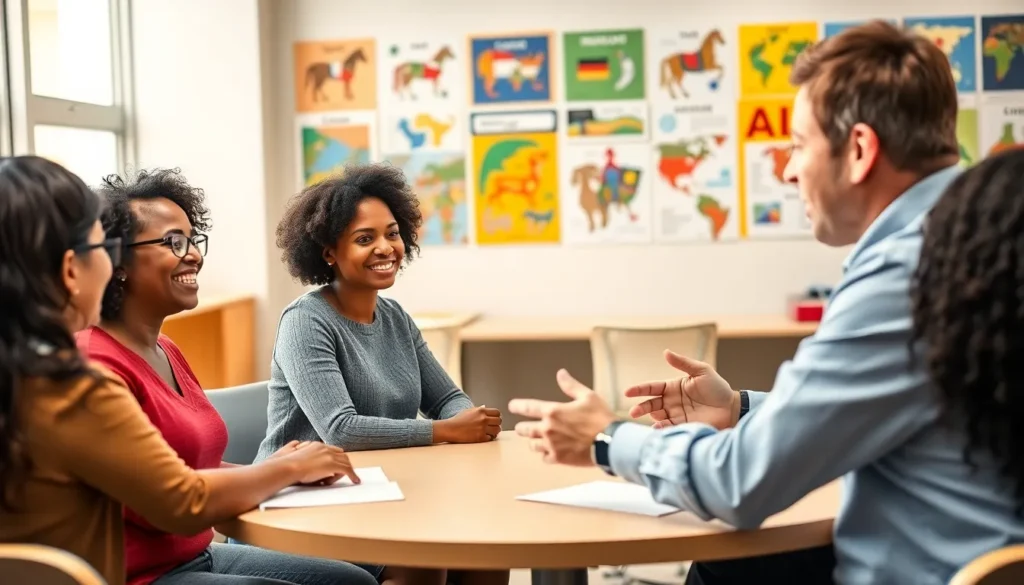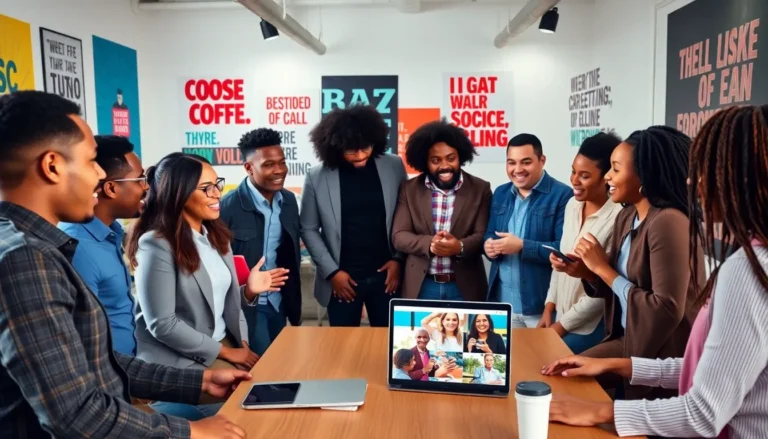In a world that’s more connected than ever, cultural awareness lessons are like the secret sauce for navigating the diverse buffet of human experience. Imagine trying to enjoy a spicy curry without knowing it’s best paired with a cool yogurt—awkward, right? Understanding different cultures not only spices up conversations but also helps avoid those cringe-worthy faux pas that can turn a friendly gathering into a comedy of errors.
Table of Contents
ToggleOverview of Cultural Awareness Lessons
Cultural awareness lessons aim to enhance understanding and appreciation of diverse cultures. Lessons incorporate various elements, including history, customs, and communication styles. Each lesson provides insights into different cultural practices and values.
Participants engage in activities that foster empathy and respect for different backgrounds. Interactive workshops often include role-playing and discussions that challenge preconceived notions. These experiences create an environment conducive to open dialogue.
Diverse teaching methods promote engagement among learners. Videos, group discussions, and case studies highlight real-world scenarios and encourage critical thinking. Resources like articles and documentaries offer additional context for learners.
Programs target specific groups, such as workplaces, schools, and community centers. Workplace initiatives often focus on improving teamwork and enhancing productivity. Educational institutions emphasize inclusivity and respect to create a positive learning environment.
Awareness lessons contribute to the reduction of stereotypes and biases. Understanding different perspectives promotes better communication and collaboration. Ultimately, these lessons empower individuals to develop connections across cultures.
Through practical applications, cultural awareness lessons prepare individuals for global interactions. Knowledge gained from these experiences can lead to more meaningful relationships. Individuals equipped with cultural awareness skills navigate diverse environments with confidence.
Importance of Cultural Awareness
Cultural awareness plays a crucial role in fostering meaningful interactions in a diverse world. It enhances both personal and professional relationships by bridging cultural gaps.
Benefits for Individuals
Cultural awareness improves interpersonal skills, allowing individuals to connect with others from different backgrounds. Empathy grows as people learn about customs and practices that shape various cultures. Understanding diverse perspectives helps reduce misunderstandings and conflicts in communication. Strengthening self-confidence occurs when individuals feel knowledgeable about interactions in global settings. Enhanced adaptability enables people to navigate social situations effortlessly. Ultimately, growth occurs through exposure to new ideas, enriching personal development and broadening worldviews.
Benefits for Organizations
Organizations benefit immensely from cultural awareness by cultivating inclusive work environments. Improved teamwork arises when employees embrace diversity, leading to greater collaboration. Businesses experience enhanced creativity as employees share unique perspectives and ideas. Customer engagement increases when brands tailor their communications to diverse audiences. Reductions in conflicts and misunderstandings contribute to a more harmonious workforce. Enhanced global competitiveness results as organizations become adept at operating in international markets. Investing in cultural awareness training yields long-term benefits that strengthen organizational culture and productivity.
Components of Effective Cultural Awareness Lessons
Effective cultural awareness lessons involve several key components. These components ensure that participants gain comprehensive insights into diverse cultures.
Curriculum Design
Curriculum design focuses on relevance and inclusivity. Each lesson should include historical backgrounds, cultural practices, and communication styles. Participants benefit from a structured framework that emphasizes real-world applications. Incorporating current events and local cultural dynamics enhances its effectiveness. Engaging materials like articles and documentaries promote deeper understanding. Integrating assessments helps gauge participants’ progress, ensuring they grasp essential concepts. Overall, a well-rounded curriculum fosters a richer cultural perspective.
Teaching Methods
Teaching methods play a crucial role in cultural awareness lessons. Interactive workshops, role-playing activities, and group discussions foster active participation. Videos and multimedia resources keep participants engaged and demonstrate cultural nuances. Case studies provide practical examples, challenging preconceived notions while encouraging critical thinking. Small group activities allow for personal connections and shared experiences. Blended learning models enhance accessibility, accommodating various learning preferences. Ultimately, diverse teaching methods optimize learning and promote cultural competency.
Implementation Strategies
Effective implementation strategies for cultural awareness lessons enhance understanding and appreciation across diverse settings. Engaging methods optimize learning outcomes for participants.
Classroom Approaches
Classroom approaches focus on creating an inclusive environment that fosters discussions around culture. Teachers utilize interactive activities like group projects and cultural presentations, encouraging students to share their own experiences. Incorporating diverse media such as documentaries and music exposes students to different perspectives. Students participate in role-playing exercises to navigate various cultural scenarios, promoting empathy and understanding. Assessments measure student engagement and comprehension, enabling teachers to adapt methodologies accordingly. Encouraging collaboration through peer-to-peer interactions strengthens the learning experience, ultimately leading to a well-rounded education in cultural awareness.
Workplace Training
Workplace training emphasizes fostering an inclusive atmosphere that enhances team dynamics. Organizations often implement workshops that encourage open dialogue about cultural differences. Training sessions utilize case studies and real-life scenarios that relate to workplace challenges, driving home the relevance of cultural sensitivity. Participants engage in group discussions to explore best practices for initiating conversations around diversity. Subsequently, teams apply learned skills to improve collaboration and productivity in the workplace. Evaluating training effectiveness through surveys and feedback mechanisms ensures continuous improvement in cultural awareness initiatives. By prioritizing these strategies, organizations develop a culturally competent workforce prepared to tackle global challenges.
Challenges in Delivering Cultural Awareness Lessons
Delivering cultural awareness lessons presents several challenges affecting outcomes and engagement. Resistance to change often emerges among participants, as individual comfort zones may inhibit open discussions. Some attendees might feel uncomfortable addressing sensitive cultural issues, leading to disengagement during activities.
Inadequate training for facilitators further complicates lesson delivery. Facilitators play a critical role in guiding conversations and creating a safe environment, thus requiring proper training to navigate complex topics effectively. Without this training, miscommunication and misunderstanding may arise, undermining lesson objectives.
Time constraints also challenge the thorough exploration of cultural topics. Comprehensive lessons necessitate sufficient time to delve into various aspects of culture such as history, practices, and perspectives. Participants may struggle to grasp essential concepts within limited timeframes, leading to superficial understanding.
Diverse learning styles present another hurdle when delivering lessons. Each participant brings unique preferences for information processing and engagement, which can create disparities in learning outcomes. Employing a one-size-fits-all approach limits the effectiveness of cultural awareness initiatives and may alienate participants.
Limited resources additionally impact the quality of cultural lessons. Access to educational materials that accurately represent different cultures often remains scarce. Lack of audiovisual tools or interactive content may hinder facilitators’ ability to engage participants fully.
Feedback mechanisms, while important, often prove difficult to implement effectively. Gathering participants’ opinions on lesson effectiveness helps improve future sessions, yet participants may hesitate to share honest feedback. Constructing a culture of openness takes time and effort.
Addressing these challenges requires ongoing dedication and adaptability from educators and organizations. Striving for inclusive environments encourages meaningful discussions that enhance understanding across cultural boundaries. Supporting facilitators through training and resources significantly improves the overall effectiveness of cultural awareness lessons.
Conclusion
Cultural awareness lessons play a vital role in fostering understanding and respect in an increasingly diverse world. By equipping individuals with the skills to navigate cultural complexities, these lessons pave the way for meaningful interactions and collaborations.
Organizations and educational institutions that invest in cultural awareness training not only enhance interpersonal skills but also create inclusive environments that drive innovation and productivity. As participants engage in interactive learning experiences, they develop empathy and challenge stereotypes, ultimately leading to stronger connections across cultures.
Embracing cultural awareness isn’t just about learning; it’s about building bridges that connect people and ideas, enriching both personal and professional lives.











